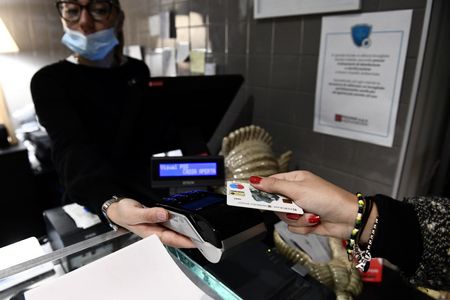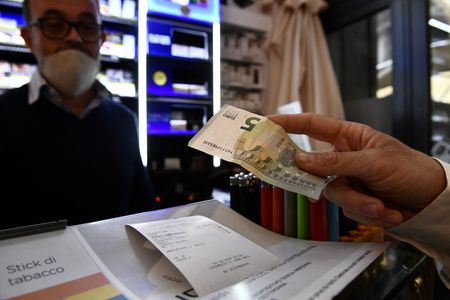By Valentina Za
MILAN (Reuters) – Dropping a plan to boost small cash payments is the smart thing for Italy to do – the measure could not have stopped the inevitable digital transition, data show, while it was already hurting the country’s image.
Italy is scrapping from the draft budget a provision on retailers who refuse card payments that limits fines to transactions worth more than 60 euros ($64).
The measure had sparked complaints from the Bank of Italy and the European Union who warned about the role that cash plays in aiding tax evasion.
A one percentage point increase in the use of cash leads to a 0.8-1.8 percentage point rise in undeclared value added tax (VAT), Italy’s central bank found.
“The government’s U-turn on card payments marks a victory for consumers and the country,” Italian consumer group Unione Nazionale Consumatori President Massimiliano Dona said.
“Thanks to the EU Commission … we won’t embarrass ourselves by going into reverse.”
Nearly 73% of respondents in a 2022 survey by The European House-Ambrosetti’s Cashless Society wished to reduce cash payments to improve speed and security, up from 60% in 2020.
With the highest median age in the EU, Italy is a digital laggard: card payments account for 32% of the total, below Europe’s 47%, but sharply up from 17% in 2017, data by payment firm Nexi show.
The axed proposal targeted small businesses who are among key supporters of Giorgia Meloni’s right wing coalition together with the self-employed.
“It was designed to please a minority of shopkeepers who are ready to put up a fight when you want to use your card to pay for coffee or a bunch of apples,” PwC partner Marco Folcia said.
“It had no real power … but it sent the wrong message.”
Even before the digital acceleration brought about by the pandemic, Italy had seen the share of cash payments in value fall to 58% in 2019 from 68% in 2016.
“It’s the consumers, not shopkeepers or legal provisions, the main driver behind the type of payment used,” Equita analysts said in comments to Reuters.
Under measures adopted to unlock EU post-pandemic recovery funds, Italy introduced in mid-2022 fines of 30 euros plus 4% of the value of the transaction for shops refusing card payments.
“The fines date back to June, yet cashless payments have been steadily increasing for years,” Equita said.
Over the past five years, Italy recorded a 6.4% compound annual growth rate of non-cash payments per capita, according to the European Central Bank, above the euro area’s 5.3%.
To defend the plan, the government has criticised the cost of digital payments saying cafe owners can hardly accept cards for 1.1 euro a cup espressos.
However, prevailing commercial offers from electronic payment suppliers charge no fees on transactions below 10 euros.
Card payment machines carry installation and monthly rental costs which price comparison site SOSTariffe says have roughly halved in Italy over the past five years. PwC calculates card processing fees in Italy are in line with Europe’s.
Cash has hidden costs, the Bank of Italy has warned: expenditures linked to robberies, insurance and transportation lift its cost for businesses to 1.0% of the transaction’s value, against 0.65% for cards.
Retailers who haven’t spent decades counting banknotes and carrying them to their local bank tend to agree.
“Cards just make our lives easier: they save us a lot of time,” said Gabriele Arnesano who runs Caffe Leopardi in the south eastern town of Maglie.
“We have a young clientele and they’re happy we let them use cards or their phones. The government’s proposal didn’t even register with us.” ($1 = 0.9405 euros)
(Reporting by Valentina Za; Editing by Chizu Nomiyama)


